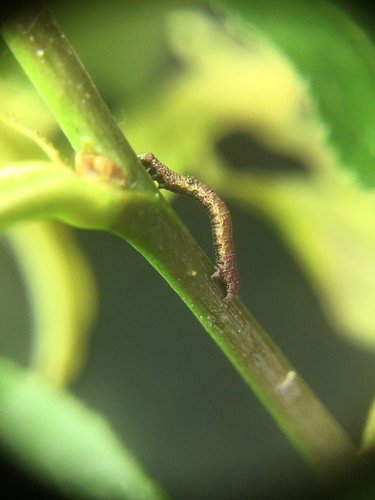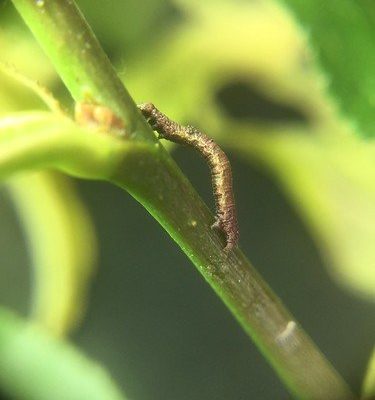
Inchworms, known scientifically as caterpillars from the Geometridae family, have a fascinating way of moving that resembles measuring an inch, hence their name. While you’re trying to cultivate healthy wooden treasures like apple or peach trees, these tiny creatures can either lend a hand or cause a bit of trouble. So, what exactly is their role, and how should you manage their presence in your garden? Let me break it down.
What Are Inchworms, Anyway?
Inchworms are not a specific type of worm but rather a stage in the life cycle of certain moths. They start as eggs laid on leaves, and once they hatch, they become the familiar little caterpillars many recognize. Their distinctive movement involves looping their bodies, which can make them look like they’re measuring the ground—hence the name. This quirky action helps them navigate their environment while avoiding predators.
In terms of appearance, inchworms can vary widely. Some are green, blending in with leaves, while others might be brown or even colorful, depending on the species. While they might seem innocuous, their diet consists mainly of leaves. So, you might be wondering, what does this mean for your young fruit trees?
How Inchworms Affect Young Fruit Trees
The impact of inchworms on young fruit trees can be a mixed bag. On one hand, these caterpillars can help in natural ecosystems by serving as food for various birds and other beneficial animals. However, they can also pose significant threats to young trees. Here’s the scoop:
– Defoliation: Inchworms love to munch on tender leaves, especially during their early growth stages. If there’s a large population, they can quickly strip a tree of its foliage, making it harder for the tree to photosynthesize. This process is essential for trees to grow and thrive. Without enough leaves, your young fruit trees might struggle to absorb sunlight and nutrients.
– Stunted Growth: Decreased foliage due to heavy feeding can lead to stunted growth and even reduced fruit production down the line. This can have long-term effects on the overall health of your trees. Healthy trees are usually strong enough to recover from minor leaf loss, but repeated damage can lead to weakening.
Identifying Inchworm Infestations
Recognizing an inchworm infestation early on can be a game-changer. These little munchers can be tricky to spot because they often blend in with the leaves. Here are some signs to look out for:
– Chewed Leaves: The first sign is usually visible damage on the leaves. Look for irregular holes or completely defoliated sections. If you see a lot of chewed-up foliage, that’s your clue that inchworms may be at play.
– Presence of Caterpillars: If you notice small caterpillars hanging around the trees, inspect them closely. Many times, inchworms are camouflaged, so use your eyes and even a magnifying glass if needed to find them!
– Webbing: Some species may spin small webs while they munch, which can also be an indicator of their presence.
Managing Inchworms Effectively
If you find that inchworms have made themselves at home in your young fruit trees, don’t panic; there are several effective ways to manage them.
– Natural Predators: One of the best ways to control inchworm populations is to encourage natural predators, such as birds or beneficial insects like wasps. You can do this by planting diverse flowers and keeping a healthy ecosystem, so your young trees have natural support.
– Neem Oil: This natural pesticide can be effective against inchworms. Spraying a diluted solution on the affected trees can help manage their numbers without harming beneficial insects. Just remember to follow instructions carefully!
– Hand-Picking: If the infestation is manageable, you can simply pick these caterpillars off your trees and relocate them to a less problematic area. Though it might feel tedious, it’s an eco-friendly method!
The Benefits of Inchworms
Now that we’ve covered the potential downsides, it’s worth noting that inchworms aren’t all bad. They can also have some benefits for your ecosystem:
– Soil Enrichment: As inchworms feed and then eventually grow into moths, they contribute organic matter that enriches the soil. This can be a good thing for your garden overall.
– Biodiversity: They are part of a larger food web. By having inchworms, you’re supporting species that rely on them, thus promoting biodiversity in your garden.
The Balance of Nature
In the grand scheme, every critter plays a role, including inchworms. They can be beneficial, but it’s crucial to keep an eye on their populations to ensure they don’t overstay their welcome. Think of them as nature’s little balance keepers; too many, and they tip the scales in the wrong direction for your young fruit trees.
You might be wondering how to maintain that balance. The key lies in regular monitoring. Spend some time each week inspecting your trees. This proactive approach can help you catch any potential issues before they escalate.
Inchworms are one of those critters that can charm and challenge gardeners at the same time. Their quirky movements are endearing, but their appetite can have serious consequences for your young fruit trees. By knowing how to identify and manage their populations, you can cultivate healthy trees that’ll bear fruit for years to come. Remember, the world of gardening is all about balance and understanding the roles that different creatures play—so keep an eye out for those inchworms, and don’t forget that healthy trees can often withstand a little nibbling! Happy gardening!

